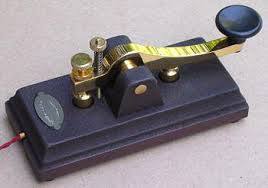Onore alla Telegrafia - Honor to Telegraphy

Il codice Morse, detto anche alfabeto Morse, è un sistema per trasmettere lettere, numeri e segni di punteggiatura per mezzo di un segnale in codice ad intermittenza e fu uno dei primi metodi di comunicazione a distanza
Samuel Morse iniziò a interessarsi di telegrafia nel 1832 e nel 1835 aveva già progettato un primitivo sistema di relè. Il sistema fu presentato pubblicamente nel 1837 e migliorato nel 1838 (anno in cui depositò il brevetto del telegrafo), infine brevettato nel 1840.
Il codice Morse originale consisteva in combinazioni di punti e linee ognuna corrispondente a un numero. A sua volta ogni numero corrispondeva a una parola ricavabile attraverso la ricerca del numero in un apposito libretto. I numeri venivano trasmessi mediante l'uso del tasto telegrafico.
Sebbene Morse fosse l'inventore del telegrafo, non eccellendo in perizia tecnica chiese la collaborazione di Alfred Vail. Vail sviluppò un sistema nel quale ogni lettera o simbolo veniva inviata singolarmente usando una combinazione di punti, linee e pause. I due convennero che fosse proprio il metodo di Vail il più adatto ad essere inserito nel brevetto che Morse si accingeva a richiedere. Fu proprio questo sistema, conosciuto come codice Morse americano, che fu usato per trasmettere il primo messaggio telegrafico.
Il codice Morse fu subito considerato lo standard per la codifica delle informazioni ed ebbe un così ampio e incontrastato successo che nessun altro sistema alternativo riuscì a soppiantarlo, rimanendo lo standard internazionale per le comunicazioni marittime fino al 1999.
Il costo di un messaggio telegrafato dipendeva dalla sua lunghezza, per questo vennero escogitati alcuni codici commerciali in modo da codificare intere frasi in gruppi di poche lettere (normalmente cinque) che venivano poi inviati come singole parole. Tra questi, il codice Q e il codice Z hanno ancora una discreta fortuna tanto che attualmente sono usati sia dai radioamatori che dagli operatori di telegrafia per informazioni di servizio come la qualità del collegamento, il cambio di frequenza o la numerazione dei telegrammi.


Morse code, also known as Morse alphabet, is a system for transmitting letters, numbers and punctuation marks by means of an intermittent code signal and was one of the first methods of remote communication
Samuel Morse became interested in telegraphy in 1832 and in 1835 had already designed a primitive relay system. The system was presented publicly in 1837 and improved in 1838 (the year in which it filed the patent for the telegraph), finally patented in 1840.
The original Morse code consisted of combinations of points and lines each corresponding to a number. In turn, each number corresponded to a word that can be obtained by searching for the number in a special booklet. The numbers were transmitted using the telegraph key.
Although Morse was the inventor of the telegraph, not excelling in technical expertise asked the collaboration of Alfred Vail. Vail developed a system in which each letter or symbol was sent individually using a combination of points, lines and pauses. The two agreed that it was Vail's method that was the most suitable to be included in the patent that Morse was about to request. It was this system, known as the American Morse code, that was used to transmit the first telegraphic message.
The Morse code was immediately considered the standard for the encoding of information and had such a broad and undisputed success that no other alternative system succeeded in supplanting it, remaining the international standard for maritime communications up to 1999.
The cost of a telegraph message depended on its length, so some commercial codes were devised in order to encode entire sentences into groups of a few letters (normally five) that were then sent as single words. Among these, the Q code and the Z code still have a good luck and are currently used by both amateurs and telegraphy operators for service information such as connection quality, frequency change or telegram numbering.
| Mistery Cache
Per trovare la soluzione occorre ascoltare l'audio qui sotto riportato e decodificarlo. Il messaggio trasmesso contiene la chiave per trovare un numero misterioso da aggiungere alle coordinate temporanee di seguito riportate trovando così le coordinate esatte.
To find the solution, listen to the audio below and decode it. Transmitted message contains the key to find a mysterious number to be added to the temporary coordinates shown below finding exact coordinates.
|
Cliccare l'audio qui sotto! Click audio below!
|
| N 45.505101 |
|
E 9.535510 |
|
E' meglio utilizzare un browser esterno per ascoltare l'audio in quanto la APP potrebbe non essere in grado di riprodurlo
It is better to use an external browser to listen to audio as the APP may not be able to play it
Buona ricerca!

